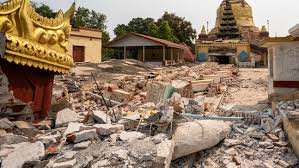A powerful earthquake struck Myanmar, causing widespread damage and prompting the Thai Prime Minister to declare a state of emergency. The tremors were felt across various regions, including Thailand, leading to panic and precautionary measures to ensure public safety. The earthquake has once again highlighted the vulnerability of the Southeast Asian region to seismic activities.
Magnitude and Affected Areas
The earthquake, measuring 7.0 on the Richter scale, struck Myanmar, with its epicenter located in the northern region of the country. The tremors were felt in Bangkok and several northern Thai provinces, including Chiang Mai and Chiang Rai. Authorities in both Myanmar and Thailand have been assessing the damage and ensuring that affected communities receive immediate assistance.
Thai Government’s Response
Following the earthquake, the Prime Minister of Thailand declared a state of emergency to facilitate rapid response efforts. Emergency response teams have been deployed to assess structural damage, provide medical assistance, and ensure public safety. Airports and transportation hubs are being monitored for any disruptions, while schools and offices in high-risk areas have been temporarily closed.
Casualties and Damage Assessment
As of the latest reports, several casualties have been confirmed in Myanmar, with many more injured due to collapsing structures. In Thailand, minor injuries and infrastructure damage have been reported, but no fatalities have been confirmed. The Thai Meteorological Department continues to monitor aftershocks and issue necessary advisories to prevent further panic.
International Assistance and Relief Efforts
The United Nations and neighboring countries have expressed their willingness to provide humanitarian aid to Myanmar. Thailand, being a close neighbor, is coordinating relief efforts and extending support to the affected areas. Rescue operations are underway, with organizations like the Red Cross and other disaster relief agencies actively working on ground zero.

Why This News is Important
1. Regional Seismic Activity and Risk Awareness
The earthquake highlights the need for enhanced seismic preparedness in Southeast Asia, a region prone to frequent tremors due to tectonic movements.
2. Impact on Thailand’s Economy and Infrastructure
With Thailand experiencing tremors, the government’s rapid response ensures minimal disruption to trade, tourism, and daily life.
3. Humanitarian Concerns and Disaster Management
This disaster underscores the need for effective international collaboration in disaster relief efforts to support affected communities in Myanmar and Thailand.
Historical Context: Earthquake Incidents in Myanmar and Thailand
Myanmar has experienced numerous significant earthquakes in the past due to its position on active fault lines. The 2016 earthquake near Bagan caused severe damage to historical sites, while the 2011 tremor in eastern Myanmar resulted in multiple casualties and infrastructural collapse. Similarly, Thailand has faced earthquakes in northern provinces due to its proximity to Myanmar’s fault lines, emphasizing the need for constant vigilance.
Key Takeaways from Thai PM Declares Emergency After Myanmar Earthquake
| Sr. No. | Key Takeaway |
|---|---|
| 1 | A 7.0 magnitude earthquake struck Myanmar, with tremors felt in Thailand. |
| 2 | The Thai PM declared a state of emergency to ensure a swift response. |
| 3 | Several casualties and infrastructural damages have been reported in Myanmar. |
| 4 | Thailand is actively monitoring aftershocks and assessing damages. |
| 5 | International aid is being mobilized to support affected communities. |
FAQs: Frequently Asked Questions
1. What was the magnitude of the earthquake in Myanmar?
The earthquake measured 7.0 on the Richter scale.
2. Which regions were affected by the earthquake?
The epicenter was in northern Myanmar, with tremors felt in Thailand, India, and China.
3. Why did the Thai PM declare an emergency?
The emergency was declared to facilitate quick response measures, ensure public safety, and monitor potential aftershocks.
4. Has Thailand suffered major damage due to the earthquake?
While Thailand experienced tremors, there have been no confirmed fatalities, only minor injuries and infrastructure damage.
5. How is the international community responding to this disaster?
Organizations like the United Nations, Red Cross, and neighboring governments are offering humanitarian aid and assistance.
Some Important Current Affairs Links

















